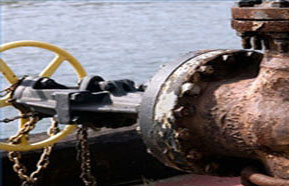pipe flange information
Pipe Flange Information

Pipe flanges insure pipe and tube sections are sealed tight.
Pipe flanges are American National Standards Institute (ANSI) rated for pressure y, corrosion resistance and maximum strength. Whenever installing flanges, either cast flanges (part of pipes or tubes) or ring flanges (slid onto to pipe or tube collars), always make sure the line's pressure will carry and what will contain. Stainless steel will work well with water or steam but can wear away quickly if subjected to caustic slurry or chemical process.
Cast Flange
- Cast flanges are part of the line section and are aligned to connect quickly to another flanged section. These flanges are strong and resistant to pressure. The disadvantage to a cast flange is if flange must be disassembled or replaced the entire length of line must also.
Ring Flange
- Ring flanges are separate parts from the line. The line has a flared end and the flange rings around the flared end to seal it tight when connected to another flange. The advantage is the ring flange allows for different diameters of line to attach using the flange as a reducer. The flange is also easily replaceable without replacing the entire section, an important quality with caustic and corrosive media. The disadvantage is the ring flange/flare connection may not be as resistant to high-pressure media in the line.
Gaskets
- Flange installation uses gasket material placed between each flange connection. Gasket material is also ANSI rated and different gaskets are needed for containing and handling different media. In most instances if a leak or failure occurs at the flange-to-flange fitting, the gasket can be considered the prime source for the malfunction. Replacing gaskets connected to either type of fitting involves the same procedure and does not necessarily involve replacing the flanges or the line.
Installation
- Installing flanges is a basic mechanical job: insert the gasket material, align the flange bolt holes and secures with the necessary number of bolts. Always bolt every hole. Don't assume leaving one or two disconnected will satisfactory seal the connection. Also, use a criss-cross pattern to tightening the bolts: tighten the bolt on top then the one at the bottom, to the left and then the right. Repeat this around the flange's circumference. This bolting procedure will apply pressure to the gasket and the facing flanges evenly and result in a complete seal. Just bolting around the circle can lead to crimping and poor alignment of the last remaining bolts.
Fastener
- Always use fasteners specified for the flange fitting. Using fasteners made of the wrong material. As an example, galvanized bolts with stainless steel flanges can lead to galvanic corrosion. Using bolts too small for the flange can allow the flange to move. Bolts too short may lead to insufficient threading and the flanges will not be secure.
sales@thermometricscorp.com